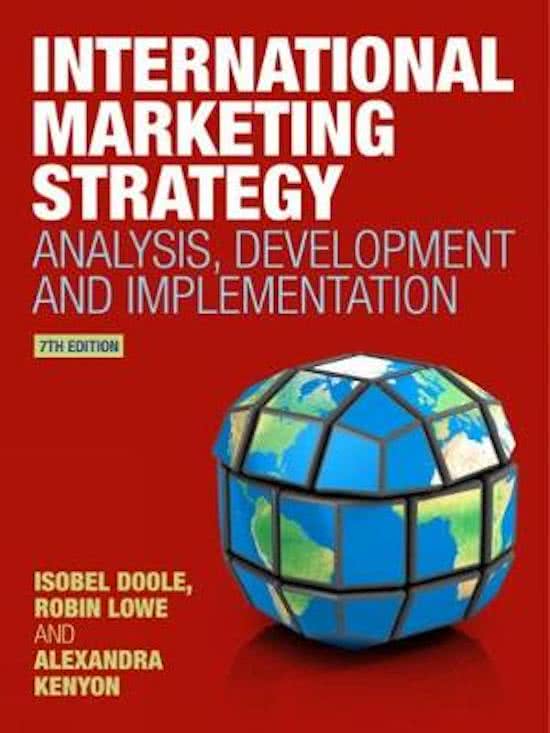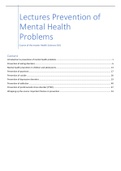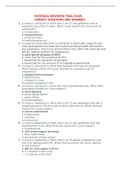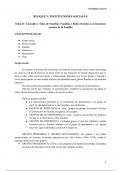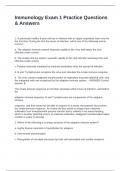Summary International Marketing
Chapter 1: An introduction to international marketing
Marketing is defined as the management process responsible for identifying, anticipating and
satisfying customer requirements profitability.
- Focussing on the needs/want of the customers
- Identifying the best method of satisfying those needs/wants
- orienting the company towards the process of providing that satisfaction
- meeting organisational objectives
International marketing involves the firm in making one or more marketing mix decisions across
national boundaries. So it involves the firm in establishing manufacturing/ processing facilities
around the world and coordinating marketing strategies across the globe.
3 different marketing levels:
- Domestic marketing
- International marketing
- Global marketing management
Domestic marketing involves the company manipulating a series of controllable variables such as
price, advertising, distribution and the product/service attributes in a largely uncontrollable external
environment that is made up of different economic structures, competitors, cultural values and legal
infrastructure within specific political geographic country boundaries.
International marketing involves operating across a number of foreign country markets in which not
only do the uncontrollable variables differ significantly between one market and another, but the
controllable factors in the form of cost and price structures, opportunities for advertising and
distributive infrastructure, are also likely to differ significantly.
Global marketing management is a larger and more complex international operation. Here a
company coordinates, integrates and controls a whole series of marketing programmes into a
substantial global effort. Here the primary objective of the company is to achieve a degree of synergy
labour rates, skill levels and market opportunities, the organization as a whole will be greater than
the sum of its parts. in the overall operation so that by taking advantage of different exchange rates,
tax rates, labour rates, skill levels and market opportunities.
How international marketing is defined and interpreted depends on the level of involvement of the
company in the international marketplace. International marketing could therefore be:
- Export marketing the firms markets its goods and/or services across national/ political
boundaries often without any adaptations to the goods and services
- International marketing the marketing activities of an organisation includes activities,
interests or operations in more than one country and where there is some kind of influence
or control of marketing activities from outside the country in which the goods/ services will
actually be sold
- Global marketing the whole organisation focuses on the selection and exploitation of
global marketing opportunities and marshals resources around the globe with the objective
of achieving a global competitive advantage
The international environment
The key difference between domestic and international marketing is the multidimensionality and
complexity of the many foreign country markets a company may operate in.
SLEPTS: Social, Legal, Economic, Political, Technological and Sustainable
, Summary International Marketing
Socio/ cultural: language, religion, aesthetics, values, material culture
Legal: international laws, regional laws, home domestic laws
Political: operational restrictions, discriminatory restrictions, physical actions
Technological: satellite communications, internet, WWW (world wide web), WIFI
Sustainability: governance, community, workforce, environment, marketplace
Economic: developed economies, emerging economies, less developed economies, currency
movement
Three legal dimensions:
- Local domestic laws these all are different. It is helpful to use experts on the separate
legal systems and laws pertaining in each market targeted
- International law this includes are number of international laws that can affect the
organisation’s activity. Three big organisation’s are: International Monetary Fund (IMF),
World Trade Organization (WTO) and The European Union (EU)
- Domestic laws in the home country: this would be important for two reasons: first, there
are often exports controls which limit the free export of certain goods/ services to particular
marketplaces. Second, there is the duty of the organization to act and abide by its
international laws in all its activities, whether domestic or international
Economic factors:
- The development economies are US, Germany, Japan, Netherlands, France, Korea, UK, Hong
Kong, and the Russian Federation. However, emerging markets are now becoming
increasingly economically powerful and moving up the ranks, especially such countries as
Brazil, India and China.
- The emerging economies are Brazil, Russia, India and China (the BRIC economies) as well as
Mexico, Indonesia, Nigeria and Turkey (the MINT economies). In these countries, there is a
huge growing demand for everything.
- Least developed countries includes underdeveloped countries and less developed countries.
The main features are low GPC, a limited amount of manufacturing activity and a very poor
and fragmented infrastructure.
Political factors:
The types of action the governments may take which constitute potential political risks to firms fall
into three main areas:
- Operational restrictions this could be exchange controls, employments policies,
insistence on locally shared ownership and particular product requirements
- Discriminatory restrictions these tend to be imposed on purely foreign firms and,
sometimes only firms from a particular country
- Physical restrictions these actions are direct government interventions such as
confiscation without any payment of indemnity, a forced takeover, expropriation,
nationalization or even damage to property or personnel through riots and
war
Sustainability factors:
Holistic model of sustainability in global marketing:
This involves ensuring in any global marketing action plan we maximize
the positive impacts while minimizing the negative: whether social or
environmental – local, regional or global.
, Summary International Marketing
Summarized differences between international and domestic marketing:
1. Culture: often diverse and multicultural markets
2. Markets: widespread and sometimes fragmented
3. Data: difficult to obtain and often expensive
4. Politics: regimes vary in stability – political risks becomes an important variable
5. Governments: can be a strong influence in regulating importers and foreign business
ventures
6. Economies: varying levels of development and sometimes unstable currencies
7. Stakeholders: commercial, home country and host country
8. Business: diverse rules, culturally influenced
9. Control: difficult to control and coordinate across markets
The planning process:
The international planning process must allow the company to answer the following the marketing
questions:
1. Where is the company now?
2. Where does it want to go?
3. How might it get there?
The major evolutionary stages of planning:
As most companies move gradually into international markets, they go through the major
evolutionary stages of planning.
- The unplanned stage (in the early stages of international marketing) finding new export
customers and money to finance its activities (short unpredictable term)
- The budgeting stage (as the business develops) a system for annual budgeting of sales,
costs and cash flow is devised
- Annual business planning (companies begin to adapt) a more formulize annual
approach to planning by including the whole business in the planning review process.
- The strategic planning stage the benefits of this approach is that all staff can be better
motivated and encouraged to work more effectively by sharing vision of the future. But there
are dangers to, long term plans often fail to cope with the consequences of unexpected
events, either environmental or political.
Three approaches (based on the annual business planning approach):
1. Top-down planning (simplest approach) setting goals and developing quite detailed plans
for middle and senior staff to implement
2. Bottom-up planning different parts of the company around the globe prepare their own
goals and plans and submit them to headquarters for approval
3. Goals down, plan up this approach is based upon senior management assessing the firm’s
opportunities and needs, setting corporate global objectives and developing broad
international strategies. Financial goals are then set for each part of the company, which has
the responsibility for developing individual strategies and plans to achieve these targets.
(mostly adopted particularly by companies that have a very diverse portfolio of business and
products)
The international marketing planning process
Stakeholder expectations
- Shareholders, customers, host government, employees in each country, pressure groups
Situation analysis
Chapter 1: An introduction to international marketing
Marketing is defined as the management process responsible for identifying, anticipating and
satisfying customer requirements profitability.
- Focussing on the needs/want of the customers
- Identifying the best method of satisfying those needs/wants
- orienting the company towards the process of providing that satisfaction
- meeting organisational objectives
International marketing involves the firm in making one or more marketing mix decisions across
national boundaries. So it involves the firm in establishing manufacturing/ processing facilities
around the world and coordinating marketing strategies across the globe.
3 different marketing levels:
- Domestic marketing
- International marketing
- Global marketing management
Domestic marketing involves the company manipulating a series of controllable variables such as
price, advertising, distribution and the product/service attributes in a largely uncontrollable external
environment that is made up of different economic structures, competitors, cultural values and legal
infrastructure within specific political geographic country boundaries.
International marketing involves operating across a number of foreign country markets in which not
only do the uncontrollable variables differ significantly between one market and another, but the
controllable factors in the form of cost and price structures, opportunities for advertising and
distributive infrastructure, are also likely to differ significantly.
Global marketing management is a larger and more complex international operation. Here a
company coordinates, integrates and controls a whole series of marketing programmes into a
substantial global effort. Here the primary objective of the company is to achieve a degree of synergy
labour rates, skill levels and market opportunities, the organization as a whole will be greater than
the sum of its parts. in the overall operation so that by taking advantage of different exchange rates,
tax rates, labour rates, skill levels and market opportunities.
How international marketing is defined and interpreted depends on the level of involvement of the
company in the international marketplace. International marketing could therefore be:
- Export marketing the firms markets its goods and/or services across national/ political
boundaries often without any adaptations to the goods and services
- International marketing the marketing activities of an organisation includes activities,
interests or operations in more than one country and where there is some kind of influence
or control of marketing activities from outside the country in which the goods/ services will
actually be sold
- Global marketing the whole organisation focuses on the selection and exploitation of
global marketing opportunities and marshals resources around the globe with the objective
of achieving a global competitive advantage
The international environment
The key difference between domestic and international marketing is the multidimensionality and
complexity of the many foreign country markets a company may operate in.
SLEPTS: Social, Legal, Economic, Political, Technological and Sustainable
, Summary International Marketing
Socio/ cultural: language, religion, aesthetics, values, material culture
Legal: international laws, regional laws, home domestic laws
Political: operational restrictions, discriminatory restrictions, physical actions
Technological: satellite communications, internet, WWW (world wide web), WIFI
Sustainability: governance, community, workforce, environment, marketplace
Economic: developed economies, emerging economies, less developed economies, currency
movement
Three legal dimensions:
- Local domestic laws these all are different. It is helpful to use experts on the separate
legal systems and laws pertaining in each market targeted
- International law this includes are number of international laws that can affect the
organisation’s activity. Three big organisation’s are: International Monetary Fund (IMF),
World Trade Organization (WTO) and The European Union (EU)
- Domestic laws in the home country: this would be important for two reasons: first, there
are often exports controls which limit the free export of certain goods/ services to particular
marketplaces. Second, there is the duty of the organization to act and abide by its
international laws in all its activities, whether domestic or international
Economic factors:
- The development economies are US, Germany, Japan, Netherlands, France, Korea, UK, Hong
Kong, and the Russian Federation. However, emerging markets are now becoming
increasingly economically powerful and moving up the ranks, especially such countries as
Brazil, India and China.
- The emerging economies are Brazil, Russia, India and China (the BRIC economies) as well as
Mexico, Indonesia, Nigeria and Turkey (the MINT economies). In these countries, there is a
huge growing demand for everything.
- Least developed countries includes underdeveloped countries and less developed countries.
The main features are low GPC, a limited amount of manufacturing activity and a very poor
and fragmented infrastructure.
Political factors:
The types of action the governments may take which constitute potential political risks to firms fall
into three main areas:
- Operational restrictions this could be exchange controls, employments policies,
insistence on locally shared ownership and particular product requirements
- Discriminatory restrictions these tend to be imposed on purely foreign firms and,
sometimes only firms from a particular country
- Physical restrictions these actions are direct government interventions such as
confiscation without any payment of indemnity, a forced takeover, expropriation,
nationalization or even damage to property or personnel through riots and
war
Sustainability factors:
Holistic model of sustainability in global marketing:
This involves ensuring in any global marketing action plan we maximize
the positive impacts while minimizing the negative: whether social or
environmental – local, regional or global.
, Summary International Marketing
Summarized differences between international and domestic marketing:
1. Culture: often diverse and multicultural markets
2. Markets: widespread and sometimes fragmented
3. Data: difficult to obtain and often expensive
4. Politics: regimes vary in stability – political risks becomes an important variable
5. Governments: can be a strong influence in regulating importers and foreign business
ventures
6. Economies: varying levels of development and sometimes unstable currencies
7. Stakeholders: commercial, home country and host country
8. Business: diverse rules, culturally influenced
9. Control: difficult to control and coordinate across markets
The planning process:
The international planning process must allow the company to answer the following the marketing
questions:
1. Where is the company now?
2. Where does it want to go?
3. How might it get there?
The major evolutionary stages of planning:
As most companies move gradually into international markets, they go through the major
evolutionary stages of planning.
- The unplanned stage (in the early stages of international marketing) finding new export
customers and money to finance its activities (short unpredictable term)
- The budgeting stage (as the business develops) a system for annual budgeting of sales,
costs and cash flow is devised
- Annual business planning (companies begin to adapt) a more formulize annual
approach to planning by including the whole business in the planning review process.
- The strategic planning stage the benefits of this approach is that all staff can be better
motivated and encouraged to work more effectively by sharing vision of the future. But there
are dangers to, long term plans often fail to cope with the consequences of unexpected
events, either environmental or political.
Three approaches (based on the annual business planning approach):
1. Top-down planning (simplest approach) setting goals and developing quite detailed plans
for middle and senior staff to implement
2. Bottom-up planning different parts of the company around the globe prepare their own
goals and plans and submit them to headquarters for approval
3. Goals down, plan up this approach is based upon senior management assessing the firm’s
opportunities and needs, setting corporate global objectives and developing broad
international strategies. Financial goals are then set for each part of the company, which has
the responsibility for developing individual strategies and plans to achieve these targets.
(mostly adopted particularly by companies that have a very diverse portfolio of business and
products)
The international marketing planning process
Stakeholder expectations
- Shareholders, customers, host government, employees in each country, pressure groups
Situation analysis

